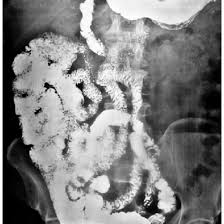
Barrium xray follow through meal
It is also known as a small bowel follow-through or fluoroscopic enteroclysisAbout Barrium xray follow through meal
A barium X-ray follow-through meal, also known as a small bowel follow-through or fluoroscopic enteroclysis, is an imaging test used to examine the small intestine. Here's a detailed explanation of this procedure:
Purpose:
A barium X-ray follow-through meal helps doctors diagnose problems in the small intestine, the part of your digestive system located between your stomach and large intestine. It's helpful in identifying issues like:
- Ulcers
- Inflammation (enteritis)
- Blockages (obstructions)
- Abnormal growths (strictures or polyps)
- Tumors
Procedure:
A barium X-ray follow-through meal typically involves the following steps:
-
Preparation:
- You may be asked to fast for several hours before the test to ensure your stomach is empty.
- Inform your doctor about any medications you take, as some may need to be adjusted before the procedure.
- You might be advised to wear loose-fitting clothing and remove any jewelry that could interfere with the X-rays.
-
Process:
- During the exam, you will likely swallow a thick, white liquid containing barium sulfate, a contrast material that coats the lining of your small intestine and helps it show up more clearly on X-rays.
- You will then be positioned under an X-ray machine and X-ray images will be taken of your abdomen over time, as the barium moves through your small intestine. This may involve changing positions several times to get different views.
- The entire procedure typically takes 1-2 hours, depending on how quickly the barium moves through your digestive system.
-
After the procedure:
- You may be encouraged to drink plenty of fluids to help flush the barium out of your system.
- You might experience constipation or diarrhea for a short time after the test due to the barium.
Benefits of a Barium X-ray Follow-Through Meal:
- Relatively painless: While you may experience some discomfort from swallowing the barium or from changing positions during the X-rays, the procedure itself is generally painless.
- Non-invasive: No needles or surgical incisions are involved.
- Detailed view: The barium coating allows for a good visualization of the small intestine for detecting abnormalities.
Things to Consider:
- Radiation exposure: While the radiation dose from X-rays is generally low, it's important to be aware of it, especially for pregnant women or children undergoing multiple scans. Discuss the risks and benefits with your doctor.
- Alternatives: In some cases, depending on the suspected condition, your doctor might recommend other imaging tests like CT scans or an ultrasound as alternatives or to get a more detailed view.
Overall, a barium X-ray follow-through meal is a valuable tool for diagnosing problems in the small intestine. If your doctor recommends this procedure, discuss any concerns you may have about radiation exposure or the process itself, and ask about the reasons behind the recommendation.